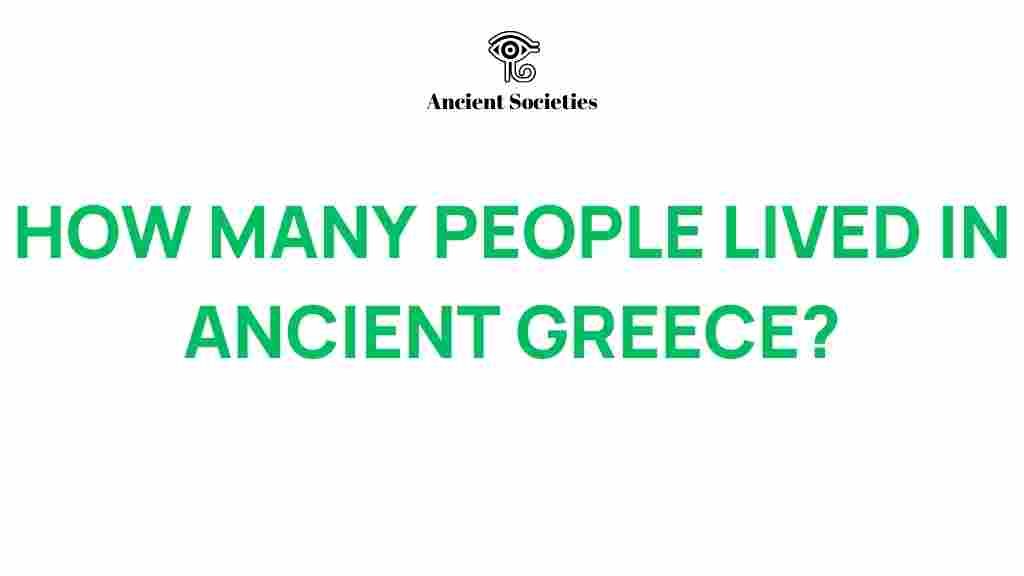Unraveling the Mysteries of Population in Ancient Greece
The history of Ancient Greece is a fascinating tapestry woven from the threads of culture, society, and demographics. This ancient civilization, renowned for its influence on art, philosophy, and politics, was also marked by a complex population structure that varied across its numerous city-states. In this article, we will delve into the demographics of Ancient Greece, explore how these figures shaped society, and examine the archaeological evidence that informs our understanding of this historical period.
The Demographics of Ancient Greece
Understanding the population of Ancient Greece requires a look at various factors that influenced its size and composition. Key elements include:
- City-States: Ancient Greece was not a unified nation but a collection of city-states (poleis), each with its own governance, culture, and population dynamics.
- Geography: The mountainous terrain and proximity to the sea shaped settlement patterns, trade, and agricultural practices.
- Migration: Population fluctuations were influenced by waves of migration, colonization, and the movement of peoples seeking new opportunities.
During the classical era, it is estimated that the population of Ancient Greece ranged from 1 to 3 million people, with significant concentrations in major city-states like Athens, Sparta, and Corinth.
City-States and Their Populations
Each city-state had its unique characteristics, which greatly influenced its population dynamics:
- Athens: Known for its democratic government, Athens had a population that included citizens, metics (resident aliens), and slaves. It is estimated that Athens had around 300,000 residents, with only a fraction being full citizens.
- Sparta: Contrasting sharply with Athens, Sparta’s population was composed mainly of warrior citizens (Spartiates) and a large number of enslaved people known as Helots, who vastly outnumbered the Spartiates.
- Corinth: As a major trade hub, Corinth’s population included a diverse range of people engaged in commerce, leading to a dynamic demographic landscape.
The differences among these city-states highlight the diversity of the ancient Greek experience, which was shaped by geography, culture, and political structure.
Factors Influencing Population Growth and Decline
Several key factors influenced the population trends in Ancient Greece:
- Fertility Rates: High fertility rates were common in ancient societies, but various factors such as warfare, famine, and disease could lead to dramatic declines.
- Warfare: Frequent conflicts between city-states often resulted in loss of life, displacement, and migration, impacting local populations.
- Economics: Economic prosperity in city-states like Athens attracted migrants and encouraged population growth, while economic decline could have the opposite effect.
Archaeological Insights into Population
Archaeology plays a crucial role in understanding the demographics of Ancient Greece. Excavations of ancient sites provide valuable insights into the lives of the people who inhabited this region:
- Urban Planning: The layout of ancient cities, including housing, public spaces, and fortifications, offers clues about population density and social organization.
- Grave Sites: Burial practices and grave goods can inform us about population composition, social stratification, and cultural values.
- Artifacts: Everyday items found during excavations help reconstruct the daily lives of ancient Greeks, revealing information about food, trade, and social interaction.
For more detailed archaeological findings, visit this archaeology resource.
Culture and Society in Ancient Greece
Understanding the demographics of Ancient Greece also involves exploring its rich culture and societal norms:
- Citizenship: Citizenship was a privilege reserved for free-born males in most city-states, creating a distinct social hierarchy.
- Slavery: A significant portion of the population comprised slaves, who played an essential role in the economy and daily life.
- Role of Women: Women had limited rights compared to men, affecting family structures and societal roles.
The interplay of these cultural elements shaped the ancient Greek population’s characteristics and societal functions.
Step-by-Step Process to Analyze Ancient Greek Population Data
To understand the population of Ancient Greece effectively, researchers can follow a systematic approach:
- Gather Historical Texts: Review ancient writings, such as those by Herodotus and Thucydides, to find references to population numbers and social structures.
- Examine Archaeological Evidence: Analyze artifacts, burial sites, and urban layouts to gain insights into population density and demographics.
- Consider Environmental Factors: Assess how geography and climate may have influenced population distribution and lifestyle.
- Evaluate Economic Data: Look into trade records and agricultural practices that could impact population growth or decline.
- Correlate Findings: Synthesize information from historical texts, archaeology, and environmental studies to create a comprehensive picture of Ancient Greek demographics.
Troubleshooting Common Challenges in Population Studies
When studying the population of Ancient Greece, researchers may encounter various challenges:
- Inconsistent Sources: Ancient texts may provide conflicting information; it’s essential to cross-reference multiple sources for accuracy.
- Loss of Artifacts: Many archaeological sites have been damaged or lost over time, limiting available evidence.
- Cultural Bias: Modern interpretations of ancient cultures may introduce bias; a careful, objective approach is crucial.
By recognizing these challenges, researchers can adopt more effective strategies for analyzing ancient populations.
Conclusion
The exploration of the population in Ancient Greece reveals a complex and dynamic history shaped by geography, culture, and societal structures. The interplay between city-states, economic factors, and archaeological findings provides a rich understanding of how demographics influenced the ancient world. As we continue to study this remarkable civilization, we gain deeper insights into the lives of those who lived in the cradle of Western civilization.
For further reading on the history of Ancient Greece, check out this historical overview.
This article is in the category History and created by AncientSocieties Team
